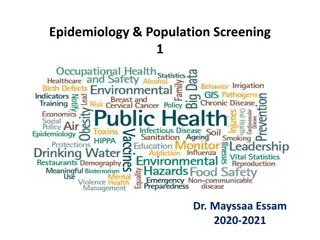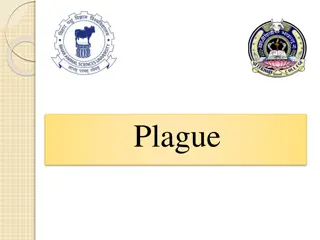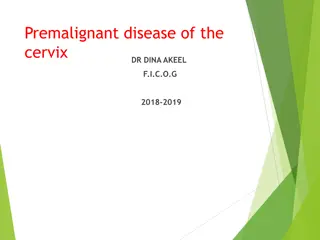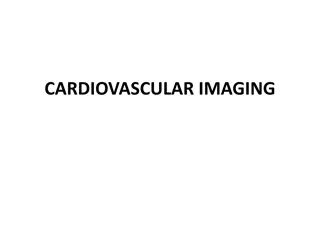All About Cervix: Anatomy, Etiology & Epidemiology
The cervix, a crucial part of female reproductive anatomy, plays a significant role in cervical health and disease. Understanding its structure, functions, and the impact of factors such as HPV infection on cervical health is essential for preventive care and early detection of abnormalities. Learn about the different aspects of cervical health, including screening protocols, management of abnormalities, and the role of HPV in cervical neoplasia. Stay informed to prioritize your reproductive health and well-being.
Download Presentation

Please find below an Image/Link to download the presentation.
The content on the website is provided AS IS for your information and personal use only. It may not be sold, licensed, or shared on other websites without obtaining consent from the author.If you encounter any issues during the download, it is possible that the publisher has removed the file from their server.
You are allowed to download the files provided on this website for personal or commercial use, subject to the condition that they are used lawfully. All files are the property of their respective owners.
The content on the website is provided AS IS for your information and personal use only. It may not be sold, licensed, or shared on other websites without obtaining consent from the author.
E N D
Presentation Transcript
??ALL ABOUT CERVIX KARIMA SALAMA
CONTENTS Anatomy, Etiology & Epidemiology SCJ HPV Screening protocol PAP Management of abnormal PAP Cervical intraepithelial lesion Cancer related Management Invasive cervical cancer Clinical picture Work-up Staging & Management
FROM ANATOMY The ectocervix ..surface of the cervix that is visualized on vaginal speculum examination is covered in squamous epithelium, and the endocervix, including the cervical canal, is covered with glandular epithelium.
FROM ANATOMY SCJ is a dynamic point that change in response to Puberty Pregnancy Menopause Hormonal stimulation In neonate it located on the exocervix, at menarche, the production of estrogen causes the vaginal epithelium filled with glycogen. Lactobacilli act on glycogen to lower the PH, stimulate the subcolumnar reserve cells to undergo metaplasia.
HPV (HPV) is divided into two classes: 1) oncogenic 2) nononcogenic. Infection with oncogenic (or high-risk) HPV usually is a necessary but not sufficient factor for the development of squamous cervical neoplasia. Therefore, only a small fraction of women infected with HPV will develop significant cervical abnormalities and cancer.
HPV HPV 16 has the highest carcinogenic potential and accounts for approximately 55 60% of all cases of cervical cancer worldwide. HPV 18 is the next most carcinogenic genotype and is responsible for 10 15% of cases of cervical cancer. Approximately 10 other genotypes are associated with the remainder of cases of cervical cancer.
HPV The current model of cervical carcinogenesis posits that HPV infection results in either transient or persistent infection. Most HPV infection is transient and poses little risk of progression. Only a small fraction of infections are persistent, but persistent infection at 1 year and 2 years strongly predicts subsequent risk of cervical intraepithelial neoplasia (CIN) 3 or cancer regardless of age.
RISK FACTORS Cofactors that increase the likelihood of persistence infection include Cigarette smoking and HPV infection have synergistic effects on the development of CIN and cervical cancer. compromised immune system. human immunodeficiency virus (HIV) infection
RISK FACTORS Oral contraceptives Long-term use of oral contraceptives has been implicated as a cofactor that increases the risk of cervical carcinoma in women who are. The excess risk of cervical cancer declines after discontinuation of oral contraceptives, and by 10 years, returns to the baseline risk in nonusers
RISK FACTORS Herpes simplex virus and chlamydia Infection with chlamydia, herpes simplex virus, or other sexually transmitted infections may be a surrogate marker of exposure to HPV rather than a causal factor itself . Alternatively, these infections may modulate host immunity, thereby facilitating persistence of oncogenic HPV
RISK FACTORS The risk of transmission of HPV correlates with the lifetime number of sex partners, but the prevalence of HPV infection is substantial (4 to 20 percent) even in those with one partner. In the United States (US), up to 50 percent of sexually active young women will have positive HPV tests within 36 months of first sexual activity, and up to 57 percent of sexually active female adolescents are infected with HPV at any one point in time
Human papillomavirus infection is most common in teenagers and women in their early 20s, with a decrease in prevalence as women age. Most young women, especially those younger than 21 years, have an effective immune response that clears the infection in an average of 8 months or reduces the viral load in 85 90% of women to undetectable levels in an average of 8 24 months
SCREENING,SCREENING,SCREENING Most cervical cancer occurs in women who were either never screened or were inadequately screened. Estimates suggest that 50% of the women in whom cervical cancer is diagnosed never had cervical cytology testing, and another 10% have not been screened within the 5 years before diagnosis. Thus, approximately 60% of diagnoses of cervical cancer are a result of inadequate screening
WHEN TO SCREEN Cervical cancer screening should begin at age 21 years 21-29yrs . PAP every 3years. 30-65yrs . PAP +HPV every 5years PAP every 3years. Above 65 no screening Vaccinated women should continue age specific screening protocol.
PAP INTERPRETATION Bethesda system classification Squamous cell abnormalities ASC ASC-US ASC-H LSIL consistent with CIN 1 HSIL consistent with CIN2, CIN3, CIS SCC
Glandular cell abnormalities Atypical glandular cell Atypical endocervical cell Atypical endometrial call No otherwise specific Atypical glandular cell favor neoplastic Endocervical No otherwise specific. AIS Adenocarcinoma
COLPOSCOPY Steroscopic binocular microscope of low magnification. 3% ascetic acid to remove adherent mucus & cellular debris. Green filter to accentuate the vascular changes. Original squamous epithelium appears gray & homogenous. The columnar epithelium appears red and grape like. TZ glands opening that are not covered by the squamous metaplasia and by the paler color of the metaplastic epithelium.
WHO NEED COLPOSCOPY Persistent atypical cells of undetermined significance (ASC-US) or ASC-US with positive high- risk human papillomavirus (HPV) subtypes ASC suggestive of high-grade lesion (ASC-H) Atypical glandular cells (AGC) Low-grade squamous intraepithelial lesions (LSIL) High-grade squamous intraepithelial lesion (HSIL) Suspicious for invasive cancer Malignant cells present
ABNORMAL FINDING ON COLPOSCOPY Leucoplakia Aceto-white area Mosaicism Punctation
BIOPSY AND ECC The most abnormally appearing areas are biopsied. Biopsies are relatively contraindicated in patients on anticoagulation medication, who have a known bleeding disorder, or who are pregnant. Endocervical curettage or sampling is performed in patients with ASC-H, HSIL, AGC, adenocarcinoma in situ (AIS), LSIL but no visible lesion, if ablative treatment is contemplated, and those with an unsatisfactory colposcopic examination
HISTOLOGICAL DIFINITIONS CIN 1 is a low-grade lesion. It refers to mildly atypical cellular changes in the lower third of the epithelium. Human papillomavirus (HPV) cytopathic effect (koilocytotic atypia) is often present. CIN 2 is considered a high-grade lesion. It refers to moderately atypical cellular changes confined to the basal two-thirds of the epithelium (formerly called moderate dysplasia) with preservation of epithelial maturation. CIN 3 is a high-grade lesion. It refers to severely atypical cellular changes encompassing greater than two-thirds of the epithelial thickness and includes full-thickness lesions (previous terms were severe dysplasia or carcinoma in situ).
CIN TO CANCER The outcome of CIN 1 lesion depends upon the preceding cytology: CIN 1 preceded by ASC-US or LSIL cytology will be diagnosed with CIN 2,3 within 6 to 24 months of follow-up . No studies have reported invasive cervical cancer in this patient population within this follow-up period. CIN 1 preceded by ASC-H or HSIL cytology, five-year risk of CIN 3+ of 15 percent
CIN TO CANCER For CIN 2 lesions, 40 to 58 percent of lesions will regress if left untreated, while 22 percent progress to CIN 3, and 5 percent progress to invasive cancer For CIN 3, the estimated spontaneous regression rate is 32 to 47 percent, with 12 to 40 percent progressing to invasive cancer if untreated
MANAGEMENT OF CIN LEEP cryosurgery
MANAGEMENT OF CIN Cone biopsy Diagnostic and theraputic Under GA Complications Bleeding Infection Cervical stenosis Cervical incompetence
CONE FOR WHOM Diagnostic cone Colposcopy is unsatisfactory ECC shows High grade lesion Discrepancy between PAP and biopsy CIS or AIS on PAP Biopsy confirm invasion
CONE AS THERAPEUTIC CIN 3 Stage IAI
NO PAP.NO COLPOSCOPY Any patient with grossly abnormal cervix should have a punch biopsy regardless of any previous result.
CERVICAL CANCER 2008 530,000 new cases 275,000 deathes worldwide.. 8-6% in developing countries. The tenth most common cause of death in developed countries 9 per 100,000 women In the developing countries second most common type of cancer (17.8 per 100,000 women) and cause death 9.8 per 100,000 women.
In USA Over 12,000 new cases anualy and 4000 cancer death Third cause of death among gynecological cancer With effective screening program and vaccination 75% decrease in incidence and mortality had noticed in the past 50years in the developed countries.
CERVICAL CANCER There are two main types of cervical cancer: squamous cell carcinoma and adenocarcinoma. Squamous cell carcinoma of the cervix is more prevalent than adenocarcinoma. Both types are found in sexually active women. Infection with specific high-risk strains of human papillomavirus (HPV) is central to the pathogenesis of cervical cancer Of the approximately 30 to 40 HPV genotypes that infect the mucosa of the genital tract, eight (types 16, 18, 45, 31, 33, 52, 58, and 35) are responsible for 95 percent of cervical cancers, and two (types 16 and 18) are responsible for about 70 percent of cervical cancer [5]. Two low-risk types (6 and 11) cause about 90 percent of benign anogenital warts.
HOW TO EVALUATE Symptoms Abnormal vaginal bleeding Poscoital Intermenstrual Postmenopausal. Persistent vaginal discharge Pelvic pain Leg swealling Urinary frequency Constipation and PR bleeding.
Physical finding Normal Weight loss? Enlarged inguinal or supraclavicular LN. Lower limb edema. Local exam . Normal cervix Lesion in endocervix Ulcerative, exophytic, grannular or necrotic. Friable cervix bleeding to touch
Clinical exam Rectovaginal exam is essential to determine the extent of the tissues invovlevement Evaluate the vaginal fornices Evaluate the pelvic side wall
PATTERN OF SPREAD Direct invasion of Cervical stroma Corpus Vagina Parametrium Lymphatic spread Pelvic Paraaortic Haematogenous Lung Liver bone
WORK UP History Examination Ask about last PAP When Result Any specific management Physical exam Biopsy for any gross lesion PAP if no lesion seen Sever bleeding packing LN asswsment
WORK UP Blood work CBC Low HB in case of bleeding KFT High creatinin in case of ureteric obstruction 30% in stage III disease. 40% in stage IV disease. Hypercalcemia indicate bone metastasis LFT Abnormal results indicate metastasis.
WORK UP Images CXR IVP Abdominal CT MRI pelvis
CERVICAL CANCER STAGES Clinical exam underanasthesia? Evaluation of the cervix Upper and lower vagina Rectovaginal exam to evaluate the parametria and pelvic side wall Cystoscopy Bladder invasion Proctoscopy Rectal invasion
FIGO STAGING Stage I The carcinoma strictly cofined to the cervix IA microscopic disease no gross lesion IA1 invasion </=3mm extension </=7mm IA2 invasion >3mm but not more than 5mm, extension not more than 7mm. IB microscopic disease more than stage IA or visible lesion IB1 visible lesion </= 4cm in greatest dimension IB2 visible lesion > 4cm in greatest dimension
FIGO STAGING Stage II Extension beyond the cervix but not to the pelvic side wall or lower vagina IIA without parametrial invasion IIA1 clinically visible lesion </=4cm in greatest dimension. IIA2 clinically visible lesion > 4cm in greatest dimension. IIB with parametrial invasion.
FIGO STAGING Stage III Tumor invade pelvic side wall & or lower third of the vagina & or causing hydronephrosis or non functioning kidney. IIIA only lower third of the vagina IIIB invading pelvic side wall & or causing hydronephrosis or non functioning kidney.
FIGO STAGING Stage IV Tumor extended beyond the true pelvis or has invade the mucosa of the rectum or the bladder. IVA.. Tumor invading adjacent organ IV B.. Tumor invading distant organ.























